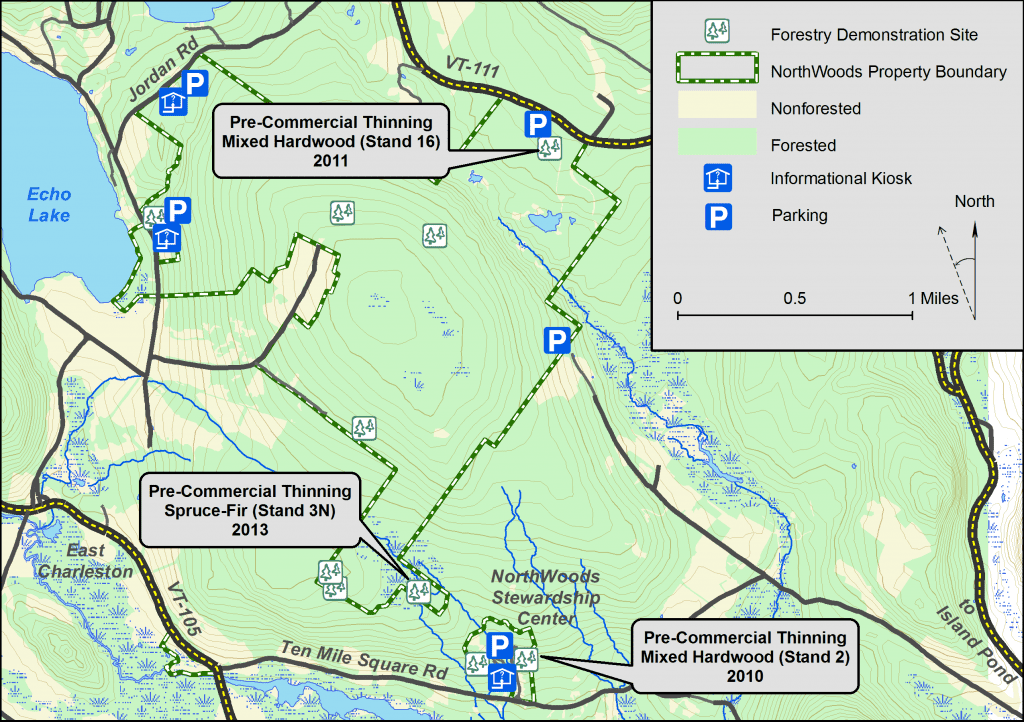Management Goals
Goals varied depending on the stand, but all pre-commercial thinning projects aimed to:
- Reduce stocking to an appropriate level, giving trees the space they need to grow (determined from an appropriate stocking chart)
- Promote desirable tree species– those that are long-lived and of high value for forest products or wildlife habitat
- Increase woody debris and snags to enhance wildlife habitat and soil health
Stand Description
Pre-commercial thinning has been applied to several areas of our Demonstration Forest, and each area is unique. So what do they have in common, and why did we choose them?All of the stands were even-aged, had a small mean DBH (average tree diameter), were overstocked (too many trees competing for not enough resources), have desirable tree species present, and are good growing sites (quality of resources, mostly related to soils, affecting the growth of a target species). Forests fitting these criteria are easy to find in the Northeast Kingdom; stands that were heavily logged in the 1960s-1980s have now grown back enough that we can start managing them with an eye toward long-term health and value.
What is Pre-Commercial Thinning?
Let’s break it down. The first part- “pre-commercial”- means that this thinning is happening before a forest is ready to have products harvested. It could be a long time before the trees are large enough to begin selling in a “commercial” harvest, but your work now will lead to more valuable logs later on.
The next part of the treatment is “thinning.” This means that scattered trees throughout the stand are removed. Other types of treatments intentionally create larger openings in the forest canopy, but the goal of a thinning is to create tiny gaps that will close within 5-10 years as the surrounding trees grow. Thinning typically is not intended to establish regeneration (a new generation of young trees in the understory), although in certain cases it can – visit our Variable Density Thinning demonstration area to see an example!
Pre-commercial thinning is often called Timber Stand Improvement, or TSI. This conveys the intention of the operation; to improve the quality of growing timber, rather than harvesting and selling it.

Case Study: NWSC Stand 2
Stand description: Mix of northern hardwoods and 15% softwood, primarily yellow birch, white ash, red maple, paper birch, balsam fir, and tamarack. Balsam fir and fewer red spruce present in the understory.
Area: 9.3 acres treated
History: This area was heavily high-graded 30 years ago, and was pastured earlier in the 1900s
Notes: Some patches of dense understory balsam fir were removed promote red spruce and hardwood saplings. Thinning increased the proportion of sugar maple and black cherry, thinned red maple stump sprouts, and reduced balsam fir understory. Girdling of larger trees resulted in 14 snags/ acre (greater than 6”dbh).
Stocking: Stand 2
| Pre-Thinning | Goal | Post-Thinning | |
|---|---|---|---|
| Basal Area (sq ft per acre) | 85 | 60 | 52 |
| Density (trees per acre) | 780 | 550 | 384 |
| Mean DBH (inches) | 4.5 | 4.5 | 5.0 |
| Acceptable Growing Stock (%) | 43 | 85 |
Case Study: NWSC Stand 3N
Stand description: The focus area in this thinning is primarily even-aged, small pole sized balsam fir and red spruce. With flat topography and shallow soils, this stand is relatively wet. The headwaters of Lang Brook (a tributary of the Clyde River) and a beaver pond are within this stand, but just outside the thinned area.
Area: 10 acres treated
History: This stand was heavily logged in 1966-69
Stocking: Stand 3N
| Pre-Thinning | Goal | Post-Thinning | |
|---|---|---|---|
| Basal Area (sq ft per acre) | 101 | 75 | 88 |
| Density (trees per acre) | 584 | 435 | 383 |
| Mean DBH (inches) | 5.6 | 6.0 | 6.8 |
| Acceptable Growing Stock (%) | 77 | 80 |

Show Me the Money!
You won’t make money on a pre-commercial thinning… yet! It’s an investment for the future. Much like opening a savings account and gaining interest, you’ll have to put some money into your forest at the beginning (in the form of time and/or labor) to gain a larger reward down the road. If you choose appropriate stands and work carefully, your pre- commercial thinning will pay for itself (and then some) in the long run!
But how can you finance it right now? The Natural Resources Conservation Service (a department of the USDA) often helps fund landowners’ forest improvement projects. You’ll need to choose a stand that fits the program’s criteria and it might not cover all costs, but it can help with your investment.
As a case study, our Stand 2 thinning cost $376/acre and we received $200/acre in NRCS funding, resulting in a net cost of $176/acre. If you can do some of the work yourself, the financial return could be even greater. (Be sure you have appropriate skills and equipment to safely work in your forest!)
Tips For Success
Often, a stand that’s in need of pre- commercial thinning will be one that was high-graded in the past (logged by “taking the best and leaving the rest”, a practice that reduces forest health and value). These forests may have large, low-value, or dying trees that were avoided in previous harvests. While it may be tempting to remove these trees for aesthetic reasons or for firewood, try to keep a few as snags (standing dead trees) or legacy trees (those left to live and senesce naturally, providing long-term habitat, structural diversity and seed source). The wildlife in your forest will thank you, and you might just develop a fondness for those big old trees!


